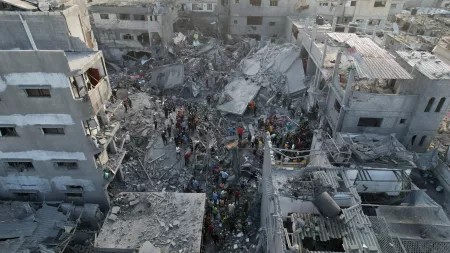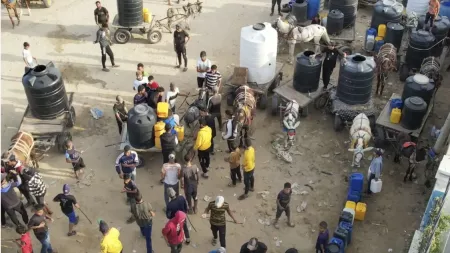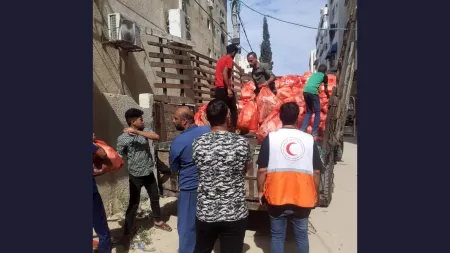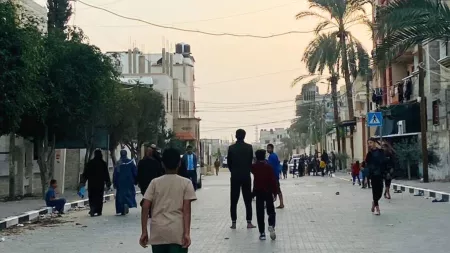The people in the war-stricken Gaza Strip experienced a weekend of relative calm after a four-day pause in the fighting went into effect early Friday morning. After 50 days of constant bombardment, the ceasefire provides temporary relief from the violence and destruction since early October.
The temporary truce has allowed 2.3 million Palestinians to sleep without constant bombing for the first night in seven weeks and provided some time to secure food and water, access medical support, and buy warm clothes for the cold winter nights in tents and destroyed buildings.
We were able to go to the market and buy some warm clothes for our small children. It gets very cold at night, and when we had to flee from our homes, we were not able to bring any winter clothes with us,our colleague Saaed Rafiq Al-Madhoun, Gaza’s emergency response coordinator, told us.
Saaed fled with his wife and five children aged one to twelve years from Gaza City to Khan Younis, one of the cities in the South many residents have evacuated to. “Everyone is out this weekend, trying to buy vegetables and other food. The prices on the market can be up to four-five times higher than before, so many people struggle to cover their basic needs,” said Saaed.
A realization of loss
Unfortunately, for many, despite the temporary relief the pause brings, this is also a time mixed with sadness as people take stock of what has been lost forever. Many returned to their homes, finding nothing but debris and scorched ground, and the need to retrieve bodies of loved ones from underneath the rubble. Also, for the first time, the phone connection improved and allowed people to check on their family, friends, and their homes in Gaza City.
Finally receiving updates did not bring good news for Saaed: “I was able to speak to a friend who went to check on our home in Gaza City. Unfortunately, our family house is completely destroyed due to airstrikes. While I felt relief about the truce, I feel very upset and down because I have certainty now that the place where we gathered with our friends and family, all our assets and memories, are lost."
My children keep asking me when we can go back home. I haven’t been able to tell them yet that we’ve lost it. Unfortunately, our story is not unique. Everyone around us has lost almost everything, often mourning numerous family members,added Saaed.
According to the UN, an estimated 1.7 million people are newly displaced – that is 74% of the entire population. Half of all buildings across northern Gaza have been damaged or destroyed. Only four out of 24 hospitals in the North are functional, while in the South only eight out of eleven medical facilities are operational. Other critical infrastructures such as water networks, sanitation facilities, and grain mills have been razed to the ground.

Insufficient aid: relief falls short of meeting Urgent Needs
Since the truce on Friday morning, hundreds of aid trucks were able to deliver food, water, medicine, and fuel. The bulk of the aid was distributed in the South. “Most of the aid was distributed to people living in shelters such as schools,” Saaed said. “Huge numbers of displaced people did not find shelter in the UNRWA centers, and they live with relatives. But their hosts can barely afford to cover the needs of their immediate family, especially since many of them were employees and were not paid for almost two months. We really worry about all the families who live in more remote and difficult-to-reach areas, who are hosted by relatives. All these people urgently need support as their needs are huge.”

“I heard from people who were queuing for up to 12 hours to fill gas canisters for cooking. They are hoping they can prepare themselves for the coming days, especially given their worry that this might be a one-off opportunity for the time to come,” Saaed told us via WhatsApp. “Many people also tried to fill up their cars. I went to one of the fuel stations, but the queue was way too long. I have heard from others that by the time they had waited for hours the fuel was already gone, as the amount was very limited. Unfortunately, we still do not have any clean water, even now. Four days of truce are not enough to deal with the numerous challenges people are facing.”
What will happen tomorrow?
While people report finally having been able to sleep and breathe again, the provisional nature of the pause and its scheduled end in a day’s time looms like a dark shadow.
What will happen on Tuesday night? Will our children be safe? The limited respite at the moment is hard to fully enjoy, when we don’t know how much more suffering we will have to endure once fighting resumes again,said Saaed.
CARE is urgently calling to turn the humanitarian pause into a permanent ceasefire and for unrestricted humanitarian access to reach survivors. More than 14,000 people have reportedly been killed so far, with thousands more still missing. CARE is particularly concerned about reaching women and children who are already dying of preventable deaths, caused by lack of clean water and medical supplies.
CARE's humanitarian response in Gaza

During the four-day truce, the CARE team in Gaza was able to secure 2,000 hygiene kits and 50,000 litres of water to be distributed to vulnerable displaced people. Each kit covers the hygiene needs of a family of five during one month. Last week, CARE was able to provide badly needed medical supplies to two mobile clinics, sufficient for serving around 4,000 people for one month; 500 hygiene kits, serving 2,500 people for one month; and shelter items such as blankets, thermal blankets and mattresses for 700 families (3,500 people).
